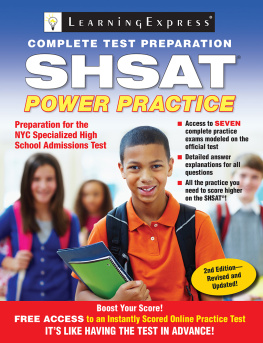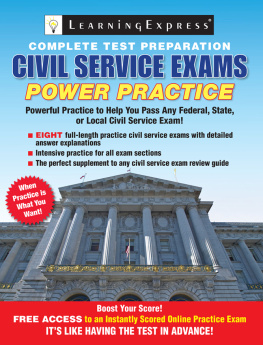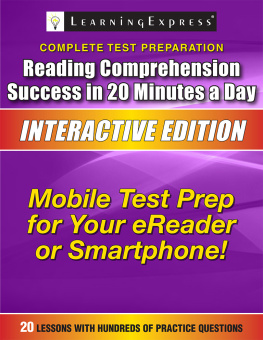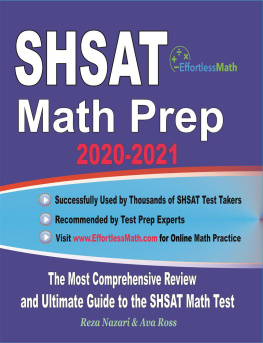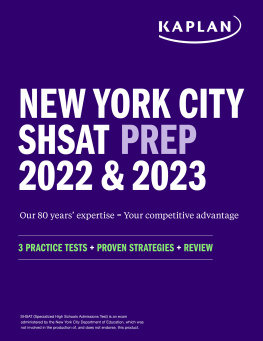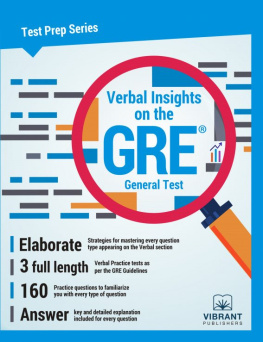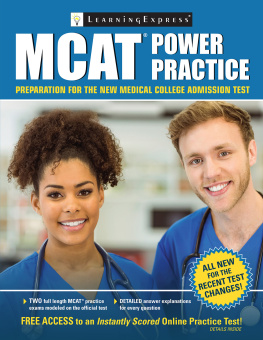CHAPTER 1 THE SCHOOLS, THE TEST, AND SHSAT POWERPRACTICE W elcome to SHSAT Power Practice ! This book is your key to getting an excellent score on New York Citys Specialized High School Admissions Test (SHSAT). If you are planning to take the SHSAT, you already have an idea of your educational goals. You feel that your interests and talents will be best fulfilled in one of New York Citys specialized high schools for academically and artistically gifted students. So, youve got your eye on one or more of the following schools: Bronx High School of Science specializes in science and math, with strong emphasis on humanities and the social sciences. Brooklyn Latin School offers an in-depth classical education, with a focus on Socratic, student-led discussions. Brooklyn Technical High School specializes in engineering, the sciences, and computer science, offering hands-on work in laboratories, computer centers, and shops.
High School for Mathematics, Science, and Engineering at the City College specializes in mathematics, engineering, and science, featuring competitions in math and robotics. High School of American Studies at Lehman College specializes in American history, preparing students for careers in politics, law, journalism, business, science, mathematics, and the arts. Queens High School for the Sciences at York College specializes in science, mathematics, and technology, offering special opportunities for students seeking a career in medicine. Staten Island Technical High School features a wide-ranging curriculum of mathematics, science, computers, engineering, and the humanities, offering hands-on work in excellent technical facilities. Stuyvesant High School specializes in mathematics and offers many extracurricular programs in music and athletics. The specialized high school not included on this list is Fiorello H.
LaGuardia High School of Music & Art and Performing Arts , which specializes in the visual and performing arts. Acceptance in this school is determined by academic record and audition or portfolio, not by the SHSAT. If you havent already set your academic sights on one or more of the eight schools listed, start thinking about it now. Before you take the SHSAT, you must indicate your school preferences. While you must choose at least one school as your first choice, you will improve your overall chances of acceptance if you rank more than one school. However, do not rank any schools that you do not wish to attend.
You can learn more about thespecialized high schools at the New York City De partment of Education website: schools.nyc.gov/ Accountability/resources/testing/SHSAT.htm. The SHSAT The first thing you should probably know about the SHSAT is that it is highly competitive. In 2010, about 28,000 students took the test. The SHSAT is the only basis for admission into the eight schools previously listed. Even your academic record doesnt count, so it is crucial that you do well on the SHSAT if you want to pursue the academic possibilities that these schools have to offer. This guide will help you perform to the best of your abilities on this demanding exam.
If you are an eighth- or ninth-grade student in one of New York Citys five boroughs, you are ready to take the SHSAT. Most students who take the test are in the eighth grade. You may take it while in both grades if you wish. Whats on the Test The SHSAT consists of 95 multiple-choice questions. It is divided into two parts: a verbal section and a math section. The verbal section has 45 questions of the following types: 5 scrambled paragraph questions, for which you will be expected to put sentences into their proper sequential order 10 logical reasoning questions, which will test your ability to draw logical conclusions from information presented 30 reading comprehension questions, which will test your ability to comprehend reading passages of about 350 to 450 words The math section has 50 questions in the following areas: algebra arithmetic basic coordinate graphing (eighth grade) factoring geometry (ninth grade) logic probability statistics substitution word problems The Time Factor You will have a total of 150 minutes (two and a half hours) to complete the SHSAT.
You may divide your time as you like between the verbal and mathematics sections of the tests, although it is a good idea to allow no more than 75 minutes for each section. You may use a non-calculator watch of your own to keep track of your time. You may begin with either the mathematics or verbal section. When you complete one section, you may move right on to the other one. When you run into a particularly difficult question, dont spend too much time on it. Either make the best guess you can or come back to it when you have completed the other questions.
If you complete the whole test early, use your remaining time to review answers in both sections. You are not allowed to leave the testing site until the full 150 minutes is up, so make the most of your time. Test Scoring You complete your test sheet by filling in bubbles with a #2 pencil. There is only one correct bubble for each test item. If you fill in two bubbles for an item, your answer will be marked as incorrect. Your score is based solely on correct answers.
Since there is no penalty for incorrect answers, go ahead and guess whenever you cant figure out the answer to an item. You might want to leave your guesses for last, provided you have time left over when you have completed all the questions you can reliably answer. Your raw score is based simply on your number of correct answers on the SHSAT. It doesnt mean much for your school acceptance, because individual test forms vary in difficulty. Your raw score will be recalculated as a scale score, which is adjusted according to the difficulty of test forms. It combines your scores in the mathematics and verbal sections.
Your scale score determines the school or schools to which you are accepted. Students are ranked according to their scale scores, from highest to lowest. These rankings are then weighed according to individual school preferences and the number of seats available in each school. When all the seats are filled, a cutoff score is set. If your score is lower than the cutoff score, you will not be accepted into any of the specialized high schools. Student Notification You must submit a New York City High School Admissions Application in order to receive notification of your SHSAT results and acceptance.
This application becomes available through your counselor in October. The deadline for submission is in December. You will be notified of your score and school offers in February. If you are accepted by more than one school, you have until the end of February to decide which school you wish to attend. Summer Discovery Program After youve received your SHSAT results, you may feel that your score is below the cutoff point due to circumstances beyond your control. If so, think about applying to participate in the Summer Discovery Program offered by some of the specialized high schools every year.
Performing well in this program may allow you to gain acceptance in a specialized high school despite your low score. To qualify for the program, you must have scored within a close range of the cutoff score. You must also be able to demonstrate one or more of the following: You come from a low-income family and/or attend a school with predominantly low-income students (a Title 1 school). You live in a foster home or are a ward of the state. You have lived in the United States for no more than four years and/or live in a home where the customary language is not English. Finally, your school must recommend you as a student with high potential for a specialized high school.
Ask your school counselor how to apply for the Summer Discovery Program. Getting Ready All told, there is no better preparation for the SHSAT than doing well in school and keeping your grades up. After all, the SHSAT is an evaluation of what you have learned during your academic career. Still, it is important to be able to mentally access all your years of learning easily and readily. A useful tactic is to list courses you have taken and jot down summaries of what you learned in them. For example, what books did you read in a particular English class? Which books made an impression on you, and why? Review social studies, science, and other courses in a similar manner.
Next page
